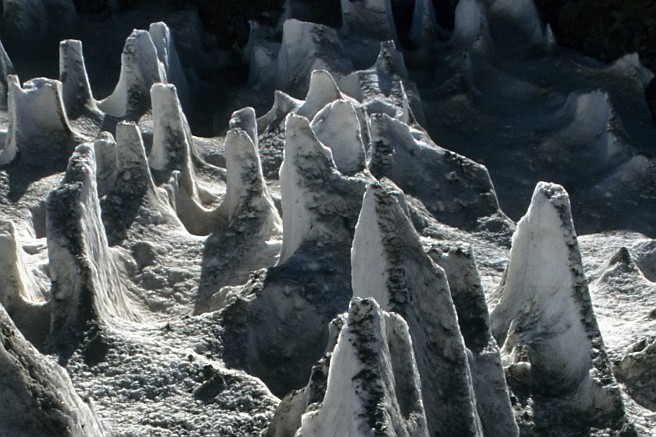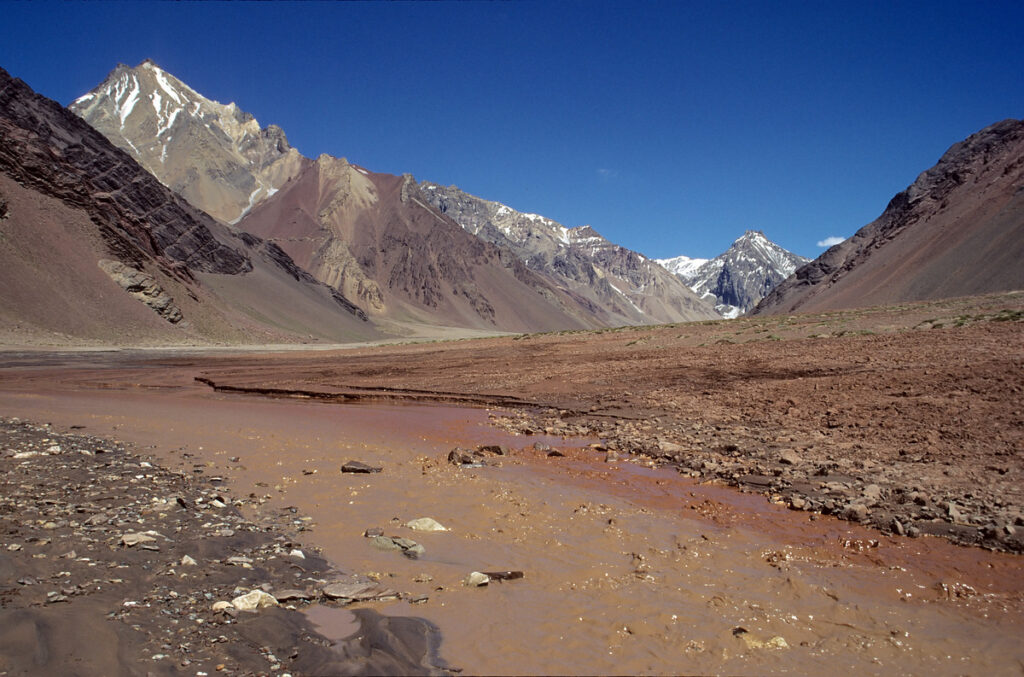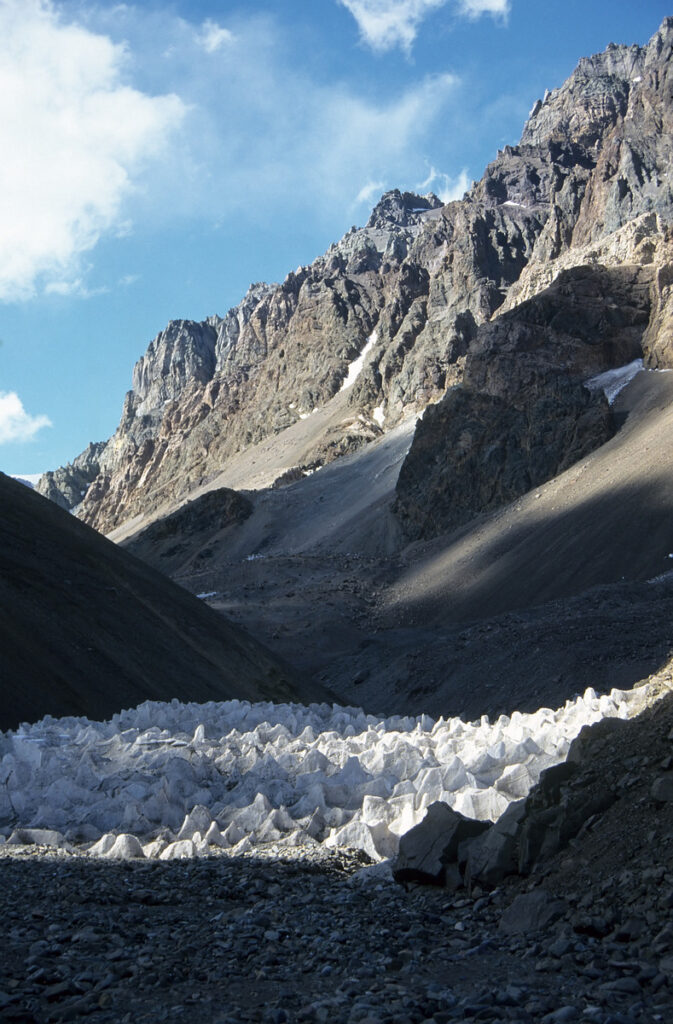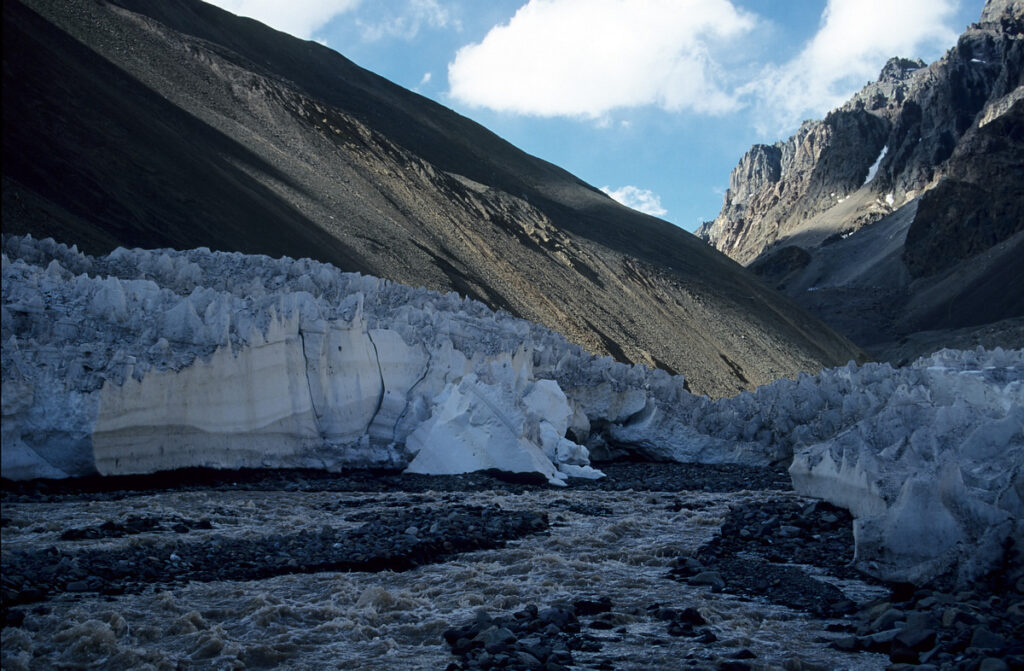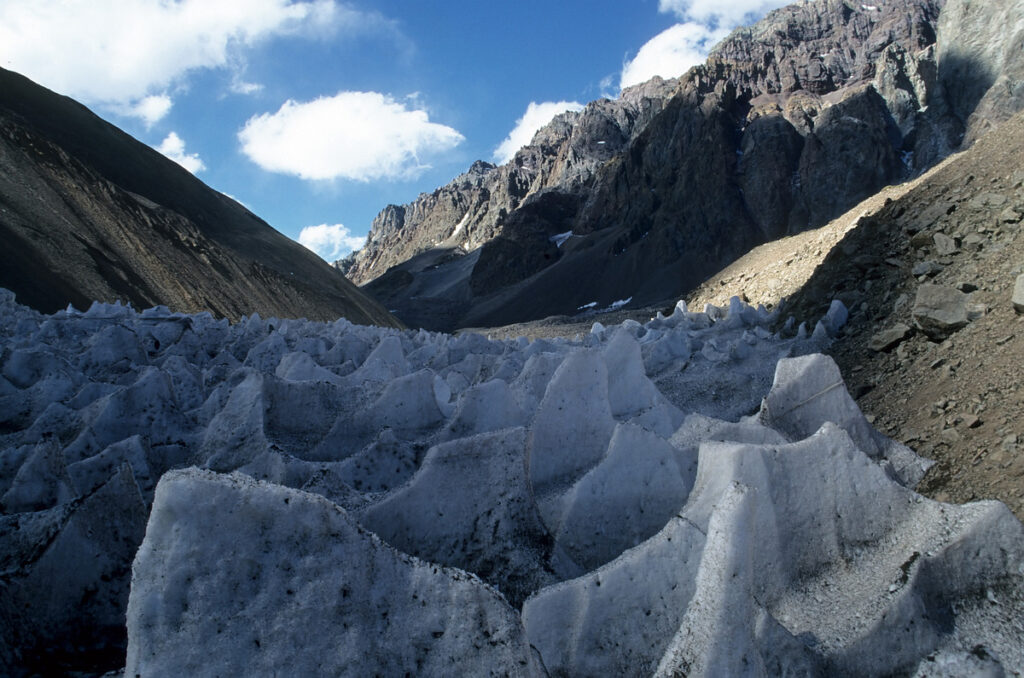When I woke up on 10th January I was encouraged by the fact that I’d slept almost continuously – much better than the previous night. The acclimatisation process seemed to be working. It was a brilliantly sunny day but with a nip in the air whenever the breeze got up. I had a lazy start, and eventually began to pack up camp. Tim and Tork had already left – heading for Ibañez Camp at 3900m (12,900 feet) : I had said that I would see them there. I knew that Confluencia was the last camp with a decent water supply – after that it was just going to be silty melt-water. I therefore spent plenty of time at the little stream that ran down through the campsite, sipping the clean but icy cold water and chatting to three girls from Buenos Aires who were planning to trek up to Plaza Francesa. They seemed to be bravely washing as much of themselves as modesty allowed. Given the temperature of the water it wasn’t a great surprise that after a while they started shivering, and had to sprint back to their tent to warm up, with arms and legs distinctly blue. I’d more or less resigned myself to two weeks without a proper wash.
Eventually, after a major struggle I had everything in the rucksack or in the “overflow” day sack, and at about eleven o’clock off I headed once more. The path ascended the steep hillside above the camp, in a series of zigzags, and my rucksack felt extremely heavy (it was). After half an hour I heard yells behind and was soon overtaken by a mule train, being encouraged from behind by two very rustic looking gauchos (Argentine cowboys). One of them asked me how much I would pay for them to take my rucksack, but I stubbornly refused the offer (I reckoned that since I was carrying over half as much as a mule, I had every right to be as stubborn as one). The path traversed to cross another sparkling, clean stream. I said hello to a group of Far Eastern looking people who were washing and drinking – they said they were Japanese. They were obviously on their way down, and I guessed that they were enjoying their first decent water for a couple of weeks. Sure enough, an hour later the path descended back to the valley floor, where the main stream was a chocolate colour.
The upper Los Horcones valley stretched away in front of me, wide and flat. It appeared that the path crossed the muddy stream at this point. To save either putting my plastic boots on (very time consuming) or taking my training shoes off and wading (cold), I untied my ski-sticks and used them to hop across with the help of a couple of wobbly stepping stones. It was the first time I had used the sticks. Since I couldn’t be bothered to take my rucksack off again the other side of the stream to store them, I carried on using them. After a while it was obvious that they were useful even on the flat, and it turned out that the next time I walked more than a couple of hundred metres without them was once I got back to the road, fifteen days later!
The path was not very well defined for the next few kilometres, as I headed along the flat rocky valley floor. The vegetation had already been sparse at Confluencia, and along the valley floor there were just a few tiny plants clinging on to scraps of soil between the rocks.
I crossed with a few more people, including several rather serious looking Japanese, on their way down. I caught up with an Argentine, and walked along with him for a while. He said he was just going as far as Plaza de Mulas, and was planning to work there for a few weeks with a friend of his. It seemed that in Plaza de Mulas there were people who cooked meals to sell to the clients of the guided groups, and to anyone else who wanted a change from dehydrated food. Eventually he stopped and I went on ahead : I was still on the east side of the stream, which was now divided into several channels. Another kilometre further on I stopped for lunch in the shelter of a hummock at one side of the valley – a cold breeze was blowing down the valley, just like on the previous day.
Throughout the trip, lunches generally consisted of just a glorified snack, as I hadn’t brought any bread – just crackers. I had brought some rather delicious smoked cheese and some herb flavoured soft cheese, both of which lasted the whole trip, and provided a tasty morsel in the middle of the day. Other than that, trail food just consisted of peanuts, raisins, chocolate, biscuits, crunchy bars, and peanut butter.
Once I had started again it was apparent that I had to cross over the stream, which here was split into several branches. I managed it with only minor wetting of my trainers, but noticed that there was a lot more water flowing than earlier. I hoped that I wouldn’t have to cross it yet again later. After another couple of kilometres the valley narrowed to fifty metres, before widening again. I asked some muleteers how far it was to “Campamento Ibañez” and they said twenty minutes, which was hard to believe. A little further I asked some foreigners, and they said three hours, which was even harder to believe. Ibañez was supposed to be at a narrowing of the valley. I carried on, and soon saw what had to be the camp half a kilometre further up, where the valley narrowed once more, and appeared to stay narrow. Needless to say, the camp was on the other side of the river, which looked even fuller than before. I jumped over a few smaller tributaries, and then realised that I was just going to have to get my feet wet. In I went, and it wasn’t so bad after all – it was quite refreshing in fact. I hoped my trainers would dry overnight, as I had no desire to complete the walk-in to Plaza de Mulas base camp either in wet trainers, or in plastic boots.
Thus I reached Campamento Ibañez, where there were only four tents pitched. The first two belonged to Tim and Tork, with whom I had a brief chat – Tim had come up on the East Side of the stream all the way and had kept his feet dry. Tork had done the same as I had, and had got wet. I pitched on the North side of an enormous boulder, and decided that I would see if I could put the tent up without using any pegs whatsoever. This I managed but it was quite an effort : the tent had eighteen pegging points, and each pegging point needed at least four rocks weighing a kilo or two each. If lifting a hundred kilos of rocks into position was exhausting at the altitude of Campamento Ibañez, it was going to be a lot tougher to do higher up…
I had another chat with Tork and Tim to see if they had found any clean water. No they hadn’t, and had tried using coffee filters with the river water : a very slow process, they said. No doubt Jim and Dan would make short work of it with their super hi-tech filter…or so I thought. I filled up my two litre water bag and left it to settle. The bag, having a tap at the top, was very easy to decant from. After half an hour I had water that was still a little murky, but a lot cleaner than it had been. It was certainly good enough to make my first cup of tea of the trip. Teabags were just about the only food item that I wished I had taken in greater quantity. In my desperation to cut down on bulk I had only put in enough for one cup of tea per day. Drinking huge amounts of fluid is essential for acclimatisation – and murky cold water gets distinctly unappetising after a short while. Murky tea on the other hand, is just as nice as non-murky tea.
The weather had been fairly similar to the previous day – a bit of light rain fell from clouds that had collected around Aconcagua. By and by this died away along with the wind, and the evening was pleasant. I wandered a couple of hundred metres up the valley, alongside what was now quite a torrent – a lot of snow had obviously melted that day. I came to an area of strange ice formations the like of which I had never seen before (it later turned out that they are called penitentes, and are in fact very common in the area at that time of year). They consisted of spikes of hard snow up to a couple of metres in height, and were in what approximated to nice neat rows. Also the spikes were all remarkably similar to each other – they all leant over slightly, all in the same direction. They all had stones and soil stuck to one side but not the other side. They were very curious, and I spent some time inspecting them, trying to figure them out. From a distance they really do look a line of the faithful, bowing their heads in penitence.
I then went back to the camp, and went up to the other two tents that I had seen there, to say hello. There were four Argentines from Buenos Aires province – they were trekkers, and this was their second night camping at Ibañez. They had been up to Plaza de Mulas that day to see what it was like, and were heading back to Puente del Inca the following day. I chatted for a while and then went back to my tent to have my evening meal. With half a tin of salmon I cooked the first half of one of two packets of rice that I’d brought. The evening’s menu was decided on the basis that since rice has a twenty minute cooking time at sea level, it would take too long to cook at the higher camps due to lower boiling point. Rice would therefore only be useful in the valley, up to and including base camp at Plaza de Mulas. I had brought pasta for the medium altitudes and a little powdered mashed potato as part of my high altitude ration. The idea was to try to keep cooking at high altitude to a minimum and keep high altitude rations as appetising as possible.
I was still unable to pick up anything on my radio, so I soon fell asleep. The night was a little windy, and the tent flapped a lot, but it felt secure and I eventually stopped worrying about the lack of pegs.

